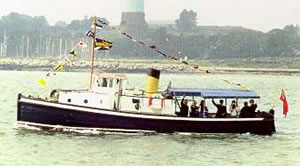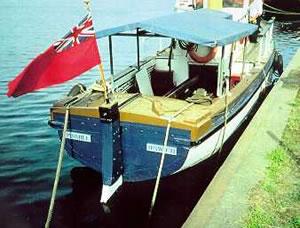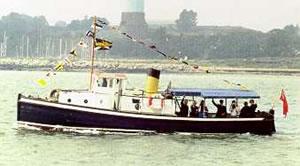
Details
Construction
Dimensions
History
PINMILL was built in 1910 by the Whitstable Barge Company, and was fitted out by Dan Marine Motor & Shipbuilding Company, Ipswich. She was originally built as an open passenger launch. She spent much of her working life in the Harwich area, initially employed by Sir Thomas Lipton’s company. In 1911 she was employed distributing victuals to the Navy under Lipton’s government contract, after which she was sold to the Great Eastern Railway to open the Harwich-Felixstowe-Shotley ferry in 1912.
At the outbreak of the First World War, PINMILL was requisitioned by the Admiralty to service the Harwich Force, a squadron of the Royal Navy. A priority for the Navy was to secure the approaches to the English Channel, to prevent elements of the German High Seas Fleet from breaking out into the Atlantic, or from interfering with British maritime trade and convoys to the continent.
Most of the major fleet units of the Grand Fleet had dispersed to the Navy's anchorage at Scapa Flow or to other North Eastern ports to monitor the northern route from the North Sea into the Atlantic. Consequently, a number of patrol flotillas were organised along the south and east coasts of England, with commands established at several of the major ports in the region. The Dover Patrol, consisting mostly of destroyers, was based at Dover, while a number of pre-Dreadnoughts and cruisers were based at Portland Harbour.
However, a large number of warships were based at Harwich, under the command of Commodore Reginald Tyrwhitt.In early 1917, the Harwich Force consisted of eight light cruisers, two flotilla leaders and 45 destroyers. By the end of the year, there were nine light cruisers, four flotilla leaders and 24 destroyers. The combination of light, fast ships was intended to provide effective scouting and reconnaissance, whilst still being able to engage German light forces, and to frustrate attempts at minelaying in the Channel. Also stationed at Harwich was a submarine force under Commodore Roger Keyes.
It was intended that the Harwich Force would operate when possible in conjunction with the Dover Patrol, and the Admiralty intended that the Harwich Force would also be able to support the Grand Fleet if it moved into the area. Tyrwhitt was also expected to carry out reconnaissance of German naval activities in the southern parts of the North Sea, and to escort ships sailing between the Thames and the Netherlands. His objectives were often complicated by the need to provide reinforcements for the Dover Patrol.
The Harwich Force fired the first shots of the war when a flotilla led by H.M.S. AMPHION sank the minelayer KÖNIGIN LUISE on 5 August 1914. During the war, the Force captured or sank 24 enemy merchant ships, and escorted 520 eastbound and 511 westbound ships between Dutch and British ports. Their ships also took part in the Cuxhaven Raid on Christmas Day 1914.
PINMILL operated as a ferry between the shore and the vessels of the Harwich Force in and around Harwich Harbour throughout the First World War. At the end of the war she returned to duty as the Harwich-Felixstowe-Shotley ferry, and she continued in this role until 1925.
PINMILL then became a workboat at Harwich and Parkestone Quay, one mile upriver, and, apart from service for the Navy and the Ministry of War Transport between 1939 and 1945, remained in that role until 1987, when she was laid up after sinking. PINMILL was purchased in 1988 by the Ipswich Maritime Trust for preservation. She was then renovated and operated public and charter pleasure trips from Ipswich.
PINMILL was purchased from the Ipswich Maritime Trust in May 2005 by her present owner and is undergoing complete restoration at Iron Wharf, Faversham, Kent. Upon completion she will be used as a passenger boat on the Gloucester and Sharpness Canal. We are currently lacking information on this particular vessel. If you have any information on this vessel past or present, please contact us.
Sadly on the 14th October, this vessel was detroyed by a fire in the boat yard it was being restored at.
Significance
1. What is the vessel’s ability to demonstrate history in her physical fabric?
Evidence for designs, functions, techniques, processes, styles, customs and habits or uses and associations in relation to events and people. How early, intact or rare these features are may impact on significance.
PINMILL was built as an open passenger launch by the Whitstable Barge Co. and fitted out by the Dan Marine Motor & Shipbuilding Co., Ipswich. She is of carvel timber construction, having oak beams and mainly elm planking. Her teak wheelhouse originally consisted only of two sides and a front for use by railway staff. Her primary mode of propulsion was an engine. Her original engine was a 2 cylinder Dan paraffin engine, but this was replaced in 1916 by a single cylinder British Kromhout engine, which survived until 1967. Her current engine is a three cylinder 35 bhp Lister built in 1966. She underwent major conservation works in the 1990s which included substantial re-planking, re-fastening and re-caulking. The steel engine room casing was replaced with modern materials. Her hull was originally painted dark blue, but she was painted white in 1996 for sun protection purposes. In 1998 her forward shelter was removed. She is now undergoing further conservation work.
2. What are the vessel’s associational links for which there is no physical evidence?
Associations with people or places. Off-ship research.
PINMILL has strong regional associations to the East Coast resulting from seventy-five years of continuous service in Harwich Harbour, with: the Great Eastern Railway; the London and North Eastern Railway; British Rail; and more recently, with Sealink. She was first employed by Sir Thomas Lipton’s company in 1911 distributing victuals to the Navy under government contract and the following year was purchased to act as a ferry operating within Harwich Harbour for the Great Eastern Railway Company Ltd. PINMILL is significant for having served the Royal Navy during both World Wars. In the First, she was requisitioned by the Admiralty to service the Harwich Force and she was again commandeered between 1939 and 1945. The rest of PINMILL’s working life saw her operating either as a passenger craft or a workboat. She has been recorded on the National Register of Historic Vessels since 1996 and copies of drawings showing her original configuration as an open decked launch still survive.
3. How does the vessel’s shape or form combine and contribute to her function?
Overall aesthetic impact of the vessel, her lines, material she was built from and her setting. Does she remain in her working environment?
PINMILL was originally designed and built as an open passenger launch with a pointed bow, a transom stern and a plumb straight stem. As a small ferry boat she was designed to be functional rather than aesthetically appealing, but her bright yellow central funnel and canopied after deck nevertheless contributed to a cheerful and reassuring presence. She continues to be conserved for operational use and will re-enter commercial trade as a passenger boat according to her original function. However, she will be based in future on the Gloucester and Sharpness Canal.
Source: NHS-UK team, 13 April 2017.
This statement was developed as part of the Heritage Lottery funded First World War project. http://www.ww1britainssurvivingvessels.org.uk/
Own this vessel?
If you are the owner of this vessel and would like to provide more details or updated information, please contact info@nationalhistoricships.org.uk


